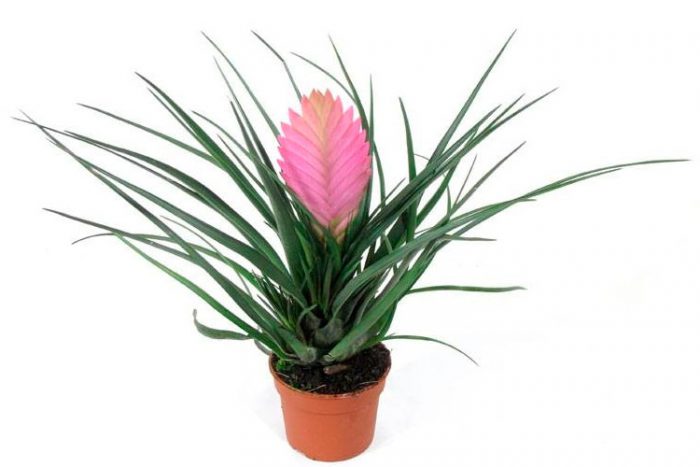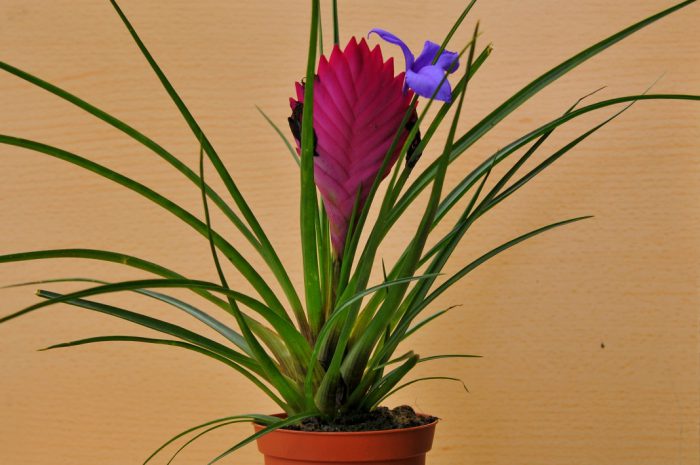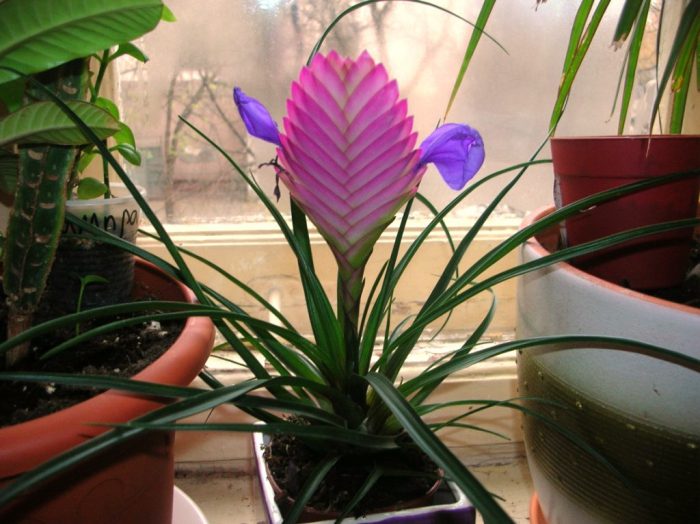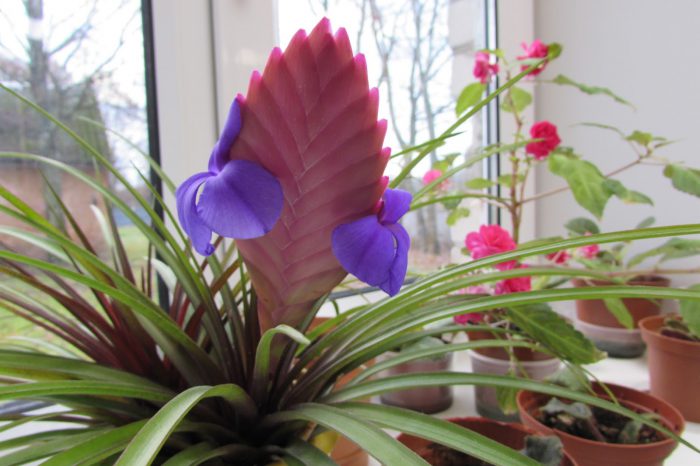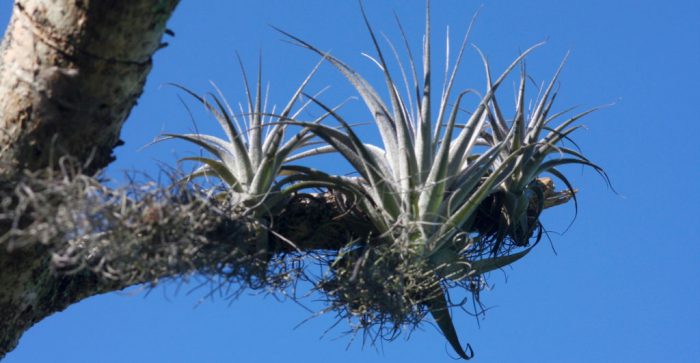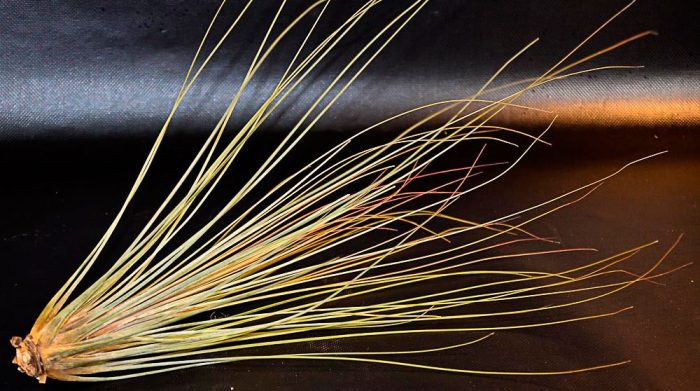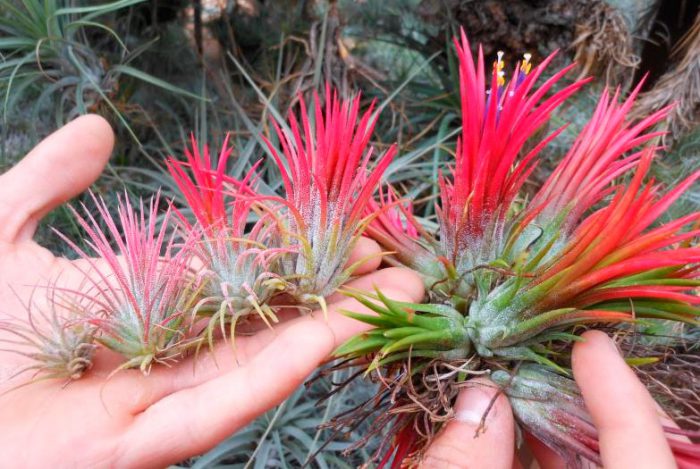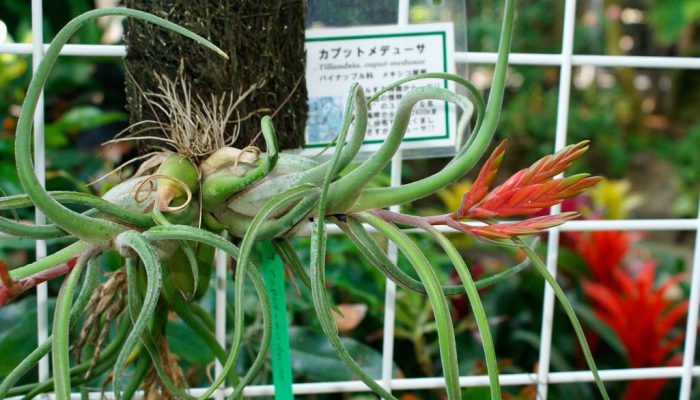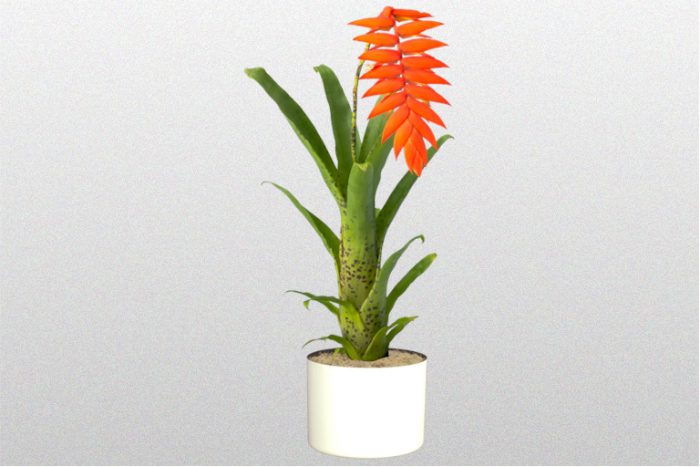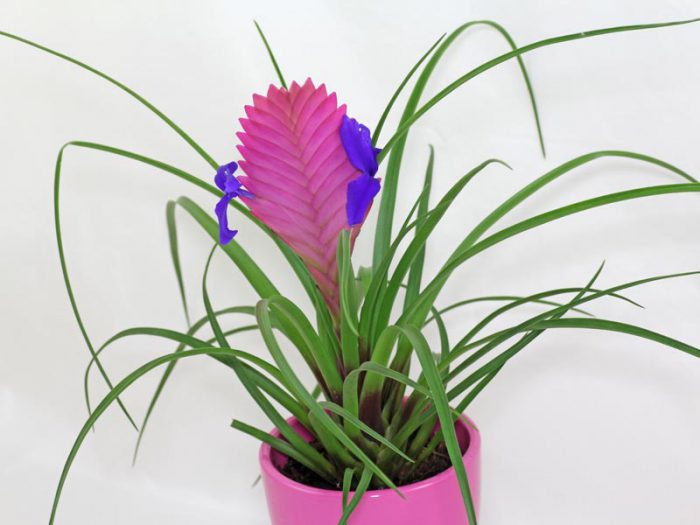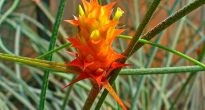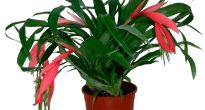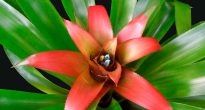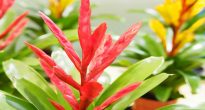A kind of herbaceous plants such as tillandsia (Tillandsia) is quite interesting and popular in home floriculture. It is directly related to the bromeliad family. This genus includes about 500 plant species. In the wild, they can be found in the subtropical and tropical regions of South and Central America. Such plants prefer to grow in coastal areas, in humid forests, and also on mountain slopes, where there is the necessary amount of precipitation.
Tillandsia has long been very popular with both amateur flower growers and professional florists. The fact is that in this genus there are plants of bizarre and very effective forms, as well as colors. So, there are plants that look like a ball of thread, a silver beard, a bunch of feathers, and even spikelets of cereals.
Tillandsia are grown like epiphytes. For their placement, driftwood or very loose soil, which consists of moss and tree bark, is suitable. The root system of this genus of plants plays a fixing role, so with the help of it they are attached to the bark of a tree or driftwood. They receive the moisture necessary for normal growth and development, as well as all the nutrients from the air. In this regard, it is so important to provide the plant with high air humidity.
Tillandsia is almost impossible to describe, as their appearance is very diverse.
However, all these plants are combined into 2 groups:
Tillandsia gray or atmospheric
These plants have almost no roots, and their rigid leaves are completely covered with scales, due to which the foliage becomes gray. In nature, they prefer to grow on trees in the upper layer of the forest.
Tillandsia green or potted
They look like familiar plants grown in indoor conditions. Their leaves are collected in a rosette, and they can be elongated-triangular or linear. In natural conditions, they prefer to grow in the lower tier of the forest on the surface of the ground or on fallen trees. They grow in shady places. And these plants are popular due to their unusual spike-shaped inflorescences.
In the most popular tillandsias, which are grown indoors, the inflorescences are a two-row spike. Distinguish between complex and simple inflorescences, consisting of several or one spike, which is loose or very dense. Most often, stipules are arranged in the form of tiles or spirally. Gray tillandsia have a reduced inflorescence and only one flower is clearly visible.
Tillandsia care at home
To understand what kind of tillandsia belongs to, you need to pay attention to how it is sold. So, terrestrial species are sold in pots, in which the leaves are only partially covered with scales or completely green. In the wild, such plants prefer to grow on the litter of tropical forests, as well as on organic debris. They are often grown in pots filled with a special substrate that has a loose structure. Many growers grow them in florariums or bottles. Atmospheric tillandsias with grayish foliage do not need land for growth. And you can buy such plants in the form of a decorative composition, in which they are attached to a piece of bark, part of a tree trunk or to a stone.
Temperature regime
They love warmth very much. So, in the summer, it feels quite well at room temperature, and in the winter, a temperature of 18 to 21 degrees is required. There are many species that grow normally at 12-14 degrees. Experts advise to make sure that the daytime temperature is slightly higher than the nighttime. So, in the warm season, the night temperature should be about 15-16 degrees. Try to protect the plant from sudden changes in temperature and cold drafts.
Gray tillandsias are not as thermophilic. In winter, it is recommended to keep them at a temperature of 14 to 18 degrees. It is very important to take this into account during the period from October to the last days of January, since at this time there is a significant decrease in illumination.
Illumination
Gray tillandsia, which have grayish tough leaves, need sunlight. However, they need the light of the evening or morning sun. In this regard, it is recommended to place them on the window sill located in the north-western or eastern part of the room. Species with grayish green or green leaves prefer rati in slightly shaded areas. So, they need a well-lit place that does not get the direct rays of the sun. They prefer diffused light.
The fact is that in tropical forests, the sun is quite bright and plants, even at the lowest level, receive a fairly large amount of light. In the autumn-winter period, it is recommended to transfer the plant to a more illuminated place, so, for this, the window sill of the western or southeastern window is suitable.
Humidity
In order for tillandsia to grow and develop normally, it needs high humidity (from 65 to 85 percent, but not less than 60 percent). Only lukewarm and soft water is used for spraying. Since this plant takes moisture directly from the air, then high humidity should be provided. In winter, when the air in the room becomes too dry due to heating devices, it is recommended to place the tillandsia in a special florarium, where it will be easier for it to provide the necessary humidity.
How to water
Any of the species of such a plant must be watered by completely immersing the plant in warm water or by abundant spraying. So, in the warm season, this procedure is carried out once a day, and a little less often in the autumn and spring. In winter, how often you need to water your tillandsia depends on the air temperature. So, if the room is warm and there is good lighting, then watering is carried out once a day, and in a cool room it is necessary to water less often.
The twisting of the leaves along the central vein into a tube indicates that the plant lacks moisture and must be immersed in water for at least 3 or 4 hours (the water must be at room temperature).
Make sure no liquid stagnates in the center of the outlet during watering. It should either completely evaporate after 2 hours or drain out.
Watering is necessary with soft, slightly acidic water (pH approximately 6.5), which does not contain chlorine. So, boiled, rain or melt water is perfect for this.
Top dressing
They are slow growing plants and do not need much fertilization. During intensive growth, rosette species are fed once every 4 weeks, using liquid fertilizers for bromileads. Those atmospheric species that grow on the bark practically do not fertilize, since the slowly decaying bark provides them with nutrients.
You can not use ordinary fertilizers for feeding. So, large amounts of nitrogen can kill tillandsia. And also you can't use organic matter, for example: humus, urea or mullein infusion (even in minimal doses).
Top dressing is carried out as follows - the required dose of fertilizer is dissolved in the liquid for irrigation through immersion or spraying.
A large number of tillandsias are able to cleanse the air of harmful substances, which, when absorbed, decompose, provide the plant with the necessary trace elements.
How to transplant
The newly acquired plant must be transplanted. However, if he already has a peduncle, then this should not be done, since at the end of flowering, the mother plant dies off, while giving offspring.
In the store, the plant can be planted in a substrate, or rather in a pot filled with peat. It can also be sold attached to the surface of the bark without a substrate.
In the wild, green species prefer to grow not on soil, but on mossy stones, snags or tree trunks. Therefore, large pieces of bark (1–2 centimeters) or a mixture consisting of Akadama (clay granulate used for growing bonsai) and bark are used for transplantation. Seramis granulate can also be used. You can also add river stones and coconut fiber to the mixture. In plain soil, the plant rots. The pot is used in a very small size, and protruding roots can be cut off.
Atmospheric views are attached to untreated timber, felt, driftwood, or coconut fiber. They are often placed in vases or flat bowls, in which the liquid does not linger or drains quickly. In the event that the tillandsia is in the water for a long time, it can rot. When watering through immersion in liquid, you cannot remove the plant from the base, because it may be damaged. Experienced growers advise that you attach the plant using soft tape to a relatively small block (a piece of bark) that can be easily removed. And hang it on a snag.
Reproduction methods
Can be propagated by daughter rosettes or seeds. The appearance of babies occurs at the end of the flowering period. So, on 1 mother plant, from 3 to 8 pieces of daughter outlets can grow. In the case when they are not separated, the plants grow in breadth and form a rather wide clump. Children with a diameter of at least 6-8 centimeters are suitable for separation.
As for Tillandsia usneiform, its shoots can be cut to any size and tied to something.
The main types of tillandsia
The most common gray tillandsia
Tillandsia Gardener (Tillandsia gardneri)
This plant has a fairly large rosette. Its folded, arched leaves help the plant to get moisture, collecting dew and condensing fog, they conduct droplets to the base of the stem. There moisture is absorbed.
Tillandsia silver (Tillandsia argentea)
This epiphytic plant has narrow leaves that are wider near the base. These leaves are curved and loose from the base.
Tillandsia juncea
This plant is an epiphyte. He has panicles consisting of reed leaves, forming a lush rosette. The leaves can be 25 to 50 centimeters long.When the flowering period begins, the plant develops a long and very showy bracts, colored red, and its purple flowers are very small.
Tillandsia usneoides
This is the most popular type, which is also called "old man's beard" or "Spanish moss". Under natural conditions, the plant prefers well-lit places or partial shade. It has very thin shoots, which can be several meters long. The filamentous leaves are only 0.1 centimeters wide and 5 centimeters long. They are arranged in two rows. On the surface of the leaves and shoots there is a huge number of scales, due to which they acquire a grayish tint. The root system is missing. Tillandsia hangs from the tree in a spectacular cascade of long stems. At home, they grow on any support, if only the plant could grow down. In the summertime, green-yellow flowers bloom, but they are not decorative.
Tillandsia violet-flowered (Tillandsia ionantha)
This epiphyte is able to attach itself to almost anything and grow in a variety of places. Curved, silvery leaves are collected in neat, small rosettes. Leaves turn reddish in summer. It has not very large spike-shaped inflorescences, painted in violet-blue color.
Tillandsia "Medusa's head" (Tillandsia caput-medusae)
This is a very popular species that is often grown at home. It is distinguished by its endurance. It has an unusual shape, reminiscent of a bulb with tight-fitting leaf bases. They bend to the sides only at the top. Most often, the leaf rosette hangs upside down. Finger-shaped or linear inflorescences are colored red. In length, purple flowers reach 32 millimeters.
Most common green tillandsia
Tillandsia dyeriana
A very beautiful epiphytic plant that has spectacular inflorescences. Bracts are colored deep red. Flowering occurs in the summer. From the middle of the rosette, a not very dense inflorescence grows, in the shape of a spikelet and attaching to a long petiole.
Tillandsia blue (Tillandsia cyanea)
This plant can be purchased at almost every flower shop. Curved, narrow leaves are collected in a rosette, and in length they reach 30 centimeters. At the base, they are colored brownish-red. On the surface of the leaf there are many small scales that fit quite tightly to each other. Flowering is observed in the summer. A dense elliptical ear appears. The bracts are painted lilac or pink, and along their edges small flowers bloom, which have a blue or pink color. The blooming of flowers occurs gradually and it starts from the top.
Tillandsia lindenii (Tillandsia lindenii)
Very similar to Tillandsia blue. Differs in the large size of the inflorescence, as well as the color of the bracts. In the inflorescence, they are rich red or light pink, and the flowers are blue and have a white eye.

